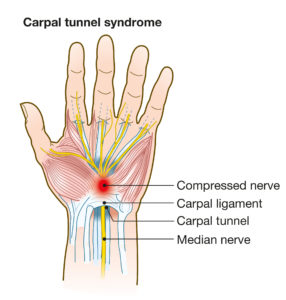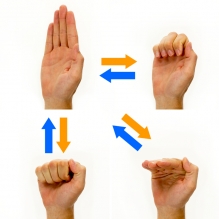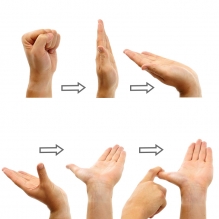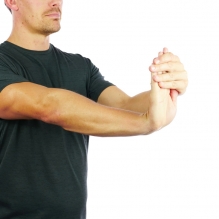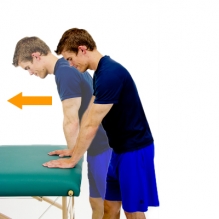
Carpal Tunnel Syndrome
Carpal tunnel syndrome (CTS) is a common condition that can cause pain, numbness, tingling, and weakness in the hand and arm. The carpal tunnel is a narrow passageway surrounded by bones and ligaments on the palm side of your wrist. Carpal tunnel syndrome is caused by pressure on the median nerve as it passes through the wrist. The median nerve provides feeling in the thumb and index, middle, and ring fingers.
In most cases, carpal tunnel syndrome symptoms begin gradually without a specific injury. Many patients find that their symptoms come and go and tend to be worst at night. However, as the condition worsens, symptoms may occur more frequently or may persist for longer periods of time, so early diagnosis and treatment is crucial.
RISK FACTORS
Most cases of carpal tunnel syndrome are caused by a combination of factors.
- Anatomy
- The carpal tunnel may be smaller in some people or there may be other anatomic differences that change the amount of space for the nerve.
- Sex
- Studies show that women are three times more likely than men to develop carpal tunnel syndrome.
- Repetitive hand use
- Repeating the same hand and wrist motions or activities over a prolonged period of time may cause inflammation which can put pressure on the nerve.
- Common aggravating activities include prolonged computer use, repeated use of hand tools, and assembly line work.
- Hand and wrist position
- Doing activities that involve extreme flexion or extension of the hand and wrist for a prolonged period of time can increase pressure on the nerve.
- Pregnancy
- Hormonal changes during pregnancy can cause swelling which may increase the pressure on the nerve.
- Comorbidities
- People with diabetes, rheumatoid arthritis, and thyroid gland imbalance are more susceptible to CTS.
TREATMENT
Proper, early treatment usually relieves symptoms associated with CTS and restores wrist and hand function.
Treatment can include:
- Activity Modification
- Take frequent breaks to rest the hand throughout the day.
- Modify your workspace to allow the wrist to remain in neutral position.
- Medication
- Over-the -counter NSAID’s or prescription medications may be recommended to temporarily ease the pain and swelling associated with carpal tunnel syndrome.
- Physical Therapy
- Physical therapists can develop a rehabilitation program designed to reduce pain and address flexibility restrictions and reduced grip strength associated with CTS.
- Physical therapists can also teach you proper ergonomics and other strategies to reduce pressure on the nerve throughout the day.
- Brace
- Wearing a splint that keep your wrist in a neutral position, especially at night, can help reduce pressure on the nerve.
- Surgery
- If conservative treatment does not relieve your symptoms, you may be a candidate for carpal tunnel release surgery to reduce the pressure on the median nerve.
CARPAL TUNNEL EXERCISES
Below are examples of carpal tunnel exercises that may help mild to moderate symptoms when combined with activity modification and bracing. Each exercise should be performed gently to avoid further irritation of the nerve. If your symptoms are getting worse stop the exercises and consult with your physician or physical therapist.
Tendon Glides
Perform the following series of movements with your hand:
- Start with an open palm and then bend your fingers to a claw hand as in the upper right image.
- Return to an open palm and then to an “L” hand” as shown in the bottom right image.
- Return to an open palm and then make a fist as in the bottom left image.
- Finally, return to an open palm and then repeat the series 5-10 times.
Median Nerve Glide Hand
- Start by making a fist.
- Open your hand and straighten fingers.
- Extend wrist back.
- Move thumb perpendicular away from hand.
- Rotate forearm so fingers point away from you.
- Use other hand to pull thumb down.
- Return to starting position and repeat 5-10 times.
Wrist Flexor Stretch
Option #1: Seated
- Straighten elbow out in front of you.
- Use opposite hand to pull your wrist and hand back until you feel a stretch in your forearm.
- Hold for 30 seconds and repeat 3 times.
Option #2: Standing
- Place both hands on a table as shown and gently lean forward until a stretch is felt along your forearm.
- Hold for 30 seconds and repeat 3 times.
References:
https://www.ninds.nih.gov/Disorders/Patient-Caregiver-Education/Fact-Sheets/Carpal-Tunnel-Syndrome-Fact-Sheet
https://orthoinfo.aaos.org/en/diseases–conditions/carpal-tunnel-syndrome/

